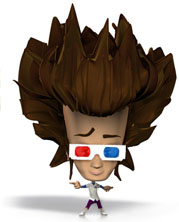Top Ten List of 3-D stereoscopic film shots
Top ten
List of stuff chucked and poked at the audience in 3-D
throughout the history of stereoscopic film
About as far out of the screen 3-D as anaglyph 3-D will allow
Eye-poking 3-D
There is a lot more possible in stereo 3-D than poking stuff in the eyes of the audience, but it's usually the one part that everybody remembers of a 3-D film. In fact, it is probably the very thing that made you interested in 3-D films and 3-D film production in the first place!So out-of-screen (negative parallax) 3-D is a good place to start when thinking of producing a 3-D stereoscopic film or video. And the best way to learn about what works well and what caused nausea and headaches, is to look at how it's been done before. Because he who does not know the 3-D past is doomed to repeat its eyestrain mistakes.
Out of Screen 3-D: how and how much
First, a little bit more about out-of-screen 3-D effects. It doesn't hurt to understand what it really is you're trying to accomplish here! Creatively, the 3-D in your project needs to pay off to actually be worth all the trouble and still integrate with the story being told. Because, narratively speaking, there is no good reason to poke stuff in the eyes of the audience. Normally, that only takes the viewer out of the story and reminds him that he is watching a 3-D movie.
Overall, the dimensionality easily distracts the viewer from the story and its characters. This way, the viewer is removed from the experience of enjoying the story and has to switch brain sides to enjoy the technicality of the 3-dimensional spectacle. And herein lies the paradox of 3-D film: you need the of-screen effects, but they can take the viewer out of the movie. Subtlety needs to be employed.
This is something special-effects-driven movies without a good plot have in common with stereoscopic cinema, and its audience may be wooed in the first few minutes, but will be unimpressed by the whole thing at the end of the movie. Also, when watching a 3-D movie that does not perform the usual bag of out-of-the-screen tricks, its audience will question the need to shoot the film in 3-D in the first place.Can 3-D out-of-screen shots be used without acknowledging the existence of the camera (camera access) and the existence of the audience? How can in-your-face 3-D be used without taking the viewer out of the story? The 3-D directors of today and tomorrow have to ask themselves these questions to take 3-D film to the next level of cinematic evolution. We certainly have! Because not employing intelligent 3-D is going to be seen as clumsy as the first attempts at cinematic storytelling of the 1900s.
Without further ado then, here's the of top ten items coming out of the screen in 3-D films and TV programs:
There are, of course, many more fantastic 3-D eye-poke shots in existence. Should you know of shots that would sit comfortably in this list any any future extended list, please don not hesite to contact 3-D Revolution Productions and we'll see if we can get our hands on that particular piece of 3-D movie magic.
The Top Ten List
Of items coming out of the screen in 3-D films
As composed by Alexander Lentjes of 3-D Revolution Productions
He's so cute! Now imagine him up close... very close...
So apologies for this image not being in 3-D; it is almost impossible to get 3-D plates of 4-D attractions. If you know of a 3-D version, do let us know!
2. Brains - The Adventures of Sharkboy and Lavagirl (2005)
Your classic 3-D brain drain
Featuring this high on the list because it's the most bizarre object in 3-D ever. The effect itself is not that memorable, but, uniquely, the brain does hit a virtual camera lens and slides down as if real brains and cameras are involved. A very rare use of the acknowledgement of the presence of a 3-D camera.
3. Paddleball ball - House of Wax (1953)
Duck! Or cover your eyes
4. Piranhas - The Adventures of Sharkboy and Lavagirl (2005)
Don't forget to feed the 3 dimensional fish
The predominant use of 3-D for horror movies ties in with the primal reaction that volumetric images still have on us. It is still a unique, very real experience, and a medium that really benefits from this emotion is horror. 3-D is also still a medium in its infancy, and is thus being used for very basic, primal stories.
Without a doubt, using dangerous animals like piranhas does exactly that: tie in with our primal reaction to both volumetric imagery and predators. Using piranhas at their actual size is a clever way to work with the size limitation of out-of-screen objects. This size limitation is dictated by the fact that 3-D images mustn’t be cut off by the screen edge and the available space in which objects can come out of the screen is thus a narrow, cone-shaped area. So all round, using piranhas is a logical, well thought out 3-D solution.
5. Tarantula - Shrek 4-D (2003)
A big, fat, hairy spider - right in your face!
6. Pistons - Motor Rhythm (1936)
An animated Chrysler engine - they don't make 'em like that any more
7. Van Gogh’s paint - Medium – Still Life (2005)
Painting in 3-D was driving Van Gogh crazy
Very creative use of 3-D. Here we have Vincent van Gogh pouring paint onto a sheet of glass just over an upward-looking camera and then start brushing it to start his painting. Well though out, very well executed, but why is this section in 3-D again? This episode of Medium struggles to come up with a good reason to do 3-D and although the use of the 3-D is very well done, there is no real story-driven reason to suddenly have 3 dimensional scenes in an otherwise flat episode...
8. Lance with liver - Flesh for Frankenstein (1973)
Quite a dramatic de-livery
Pure gruesomeness and extreme fleshploitation - Andy Warhol at his film making best. This 3-D shot is a classic pole-poke as employed in many, many 3-D films, but with the added bloody liver at the end of it. Maximum gore, if pretty much fantasy, in your face!
9. Birthday Cake - The Three Stooges – Pardon my Backfire (1953)
The Three Stooges doing what they do best: good ol' pie throwing
Suspended on wires to approach the camera at a slow speed, in a straight line. Perfect for 3-D. It also fits in perfectly with the whole setup of this Three Stooges short: every shot is thought out to be able to chuck things at the camera in a complete clowning around vaudeville slapstick act. Nothing wrong with a little bit of pie throwing, but if you’re going to do it, do it right, just like this!
10. Fish Head - Jaws 3-D (1983)
Fish head!
You’ve got 90 minutes of film, a big production budget and an amazing franchise as a subject to do some interesting things in 3-D with. So what do you decide to have come out of the screen? A fish head!
That’ll please them for sure. A fine example of why 3-D didn’t stick around longer in the 1983-84 fad, being outdone in amount of releases and quality by the 1953-54 wave of 3-D films. Here’s hoping and preying the current 2008-09 period of 3-D popularity manages to find better objects to poke at the audience.At 3-D Revolution Productions we can certainly help you seriously to do just that: creating compelling, thrilling and well thought out 3-D shots. Just contact us for more information on we can help you with your 3-D Film Production.




